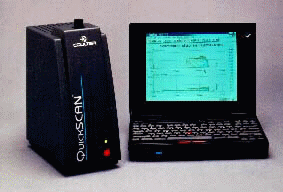
PrincipleThe design principle of the Coulter QuickScan is the association of scanning and backscattering/transmission detectors. The optical system is designed around a new concept of a reading head which combines transmission and backscattering. It works in the near infrared (= 850 nm) where there is little absorbance of light. It is sensitive to two kinds of parameters:
ApplicationsIn comparison to other analytical instruments, the QuickScan presents an advantage of working with opaque and concentrated mixtures without the need of previous dilution. This performance makes it particularly useful to analyze the stability of emulsions, suspensions, gels and foams. The mixtures are particularly used in Cosmetics and in Pharmaceuticals as well as in other industries like agro-food, agrochemical, paints, detergents and chemistry in general. The naked eye cannot detect or quantify the two kinds of destabilization of colloidal dispersions at an early stage.
The QuickScan detects particle size and concentration variations in the mixture by scanning the whole height of the sample in transmission and in backscattering. It displays the sample profile as a macroscopic graph. Thus, transmission and backscattering profiles are flat on the whole height of the sample for a homogeneous mixture. If the mixture remains stable as a function of time, these profiles do not change. When particles migrate to the top or bottom of the sample (creaming, sedimentation), transmission and backscattering levels vary proportionally to the particle concentration in each area. On the other hand, if the particle or aggregate size increase as a function of time (coalescence, flocculation), transmission and backscattering levels change within the whole height of the sample. |








